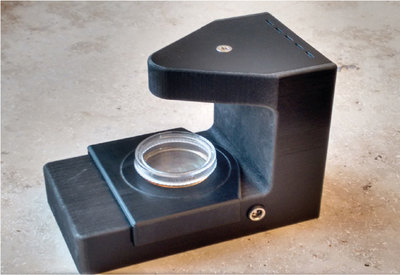Rapid asthma diagnosis with a drop of blood

Researchers at the Fraunhofer Research Institution for Marine Biotechnology and Cell Technology EMB have joined forces with some high-tech companies to develop a rapid test that requires only a drop of blood to diagnose asthma.
Asthma is one of the most common respiratory diseases worldwide, affecting more than 235 million patients. Dyspnoea, shortness of breath and coughing are just a few of the potential symptoms, with those affected at risk of suffering sudden attacks of bronchial constriction.
Identifying the disease quickly is crucial, as that is the only way to lower the threat of potentially fatal asthma attacks. It is particularly important to identify the disease early in children in order to quickly intervene and alleviate the symptoms.
However, diagnosing children is more complicated and tedious than diagnosing adults, as some of the test methods that entail blowing into a tube cannot be used for small children. Time-consuming lung function tests can also only be performed from the age of four or five.
To address this issue, Fraunhofer EMB has teamed up with the Pattern Recognition Company and Raytrix in the KillAsthma project, sponsored by the German federal state of Schleswig-Holstein, to develop a new rapid test that is expected to return a finding after just 60 to 90 min — and all it requires to diagnose asthma is a drop of blood and the immune cells it contains.
The movement profile of the blood cells of asthmatics differs from that of healthy individuals. As explained by Dr Daniel Rapoport, head of the Working Group on Cell Technology at Fraunhofer EMB, “In patients with asthma, the immune cells move much more slowly in the presence of an inflammatory stimulus.”
The researchers drew on this knowledge in developing the test set. The idea is to observe the immune cells in the drop of blood under a specially developed holographic microscope for about 90 min and, based on their movement pattern, to assess whether the patient has asthma. The microscope, also referred to as a cell scanner, enables automatic, three-dimensional cell tracking in real time. Artificial intelligence (AI) plays a key role here, recognising characteristic patterns in the complex movement patterns of thousands of cells.

The blood and a substance that triggers the inflammatory stimulus are filled into a microfluidic cartridge and then placed in the miniaturised microscope, which comprises an LED and an optical CMOS image sensor that is linked with the computer software. The images are evaluated using specially developed algorithms.
“We can observe 2000 to 3000 cells simultaneously, ensuring high statistical precision,” Dr Rapoport said. The identified movement patterns are then transferred to a neural network. Self-learning algorithms analyse the blood cell movement patterns and calculate the diagnostic index.
“AI lets us identify deviations in the patterns. We use self-learning algorithms to capture these differences. Extensive training data helps the neural networks recognise patterns and distinguish between the profiles of asthma sufferers and healthy individuals.”
It can be concluded that AI is also capable of learning other deviations from the norm, with Dr Rapoport stating, “Our method can also be used to analyse other diseases. This is especially true for autoimmune and chronic inflammatory diseases such as Crohn’s disease, ulcerative colitis and rheumatism. Diagnosing these conditions is a long, tedious process and can be expedited considerably with a tailored rapid test.
With initial tests having been successfully completed, and the image evaluation showing that the team’s holographic microscope is superior to a high-powered microscope, Dr Rapoport and his project partners are now optimising the hardware and the method. Their long-term goal is to identify individual manifestations of asthma to enable the development of personalised treatment plans.
Please follow us and share on Twitter and Facebook. You can also subscribe for FREE to our weekly newsletters and bimonthly magazine.
European Space Agency inaugurates deep space antenna in WA
The ESA has expanded its capability to communicate with scientific, exploration and space safety...
Black hole collision supports Hawking's landmark theory
Astrophysicists have witnessed a collision between two black holes that was so loud, they were...
Uncovering differences in wild and domesticated crops
Researchers have revealed insights into the genetic make-up of wild varieties of common crops...





